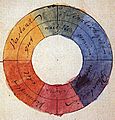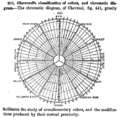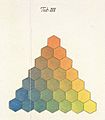Colour theory facts for kids
Colour theory is like a guide that helps us understand how colours mix and what happens when we put different colours together. It also teaches us about different types of colours, like primary, secondary, and tertiary colours, which are all based on the colour wheel.
People started writing about colour theory a long time ago. For example, Leone Battista Alberti wrote about it around 1435, and Leonardo da Vinci included ideas about it in his notebooks around 1490.
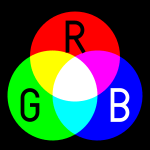 |
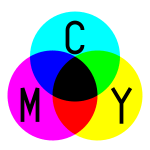 |
|
|
Additive colour mixing
|
Subtractive colour mixing
|
Early ideas about colour theory focused on "pure" or ideal colours, thinking about how we see them rather than how they work in the real world. This led to some mistakes in how people understood colour.
Contents
How Light and Paint Mix Colours
It's important to know that light mixes differently from paints, inks, or dyes.
- When you mix coloured lights, it's called additive color mixing. For example, if you mix red, green, and blue light, you get white light.
- When you mix paints or inks, it's called subtractive color mixing. This is because the pigments in the paint absorb certain colours of light and reflect others. When you mix many colours of paint, they absorb more light, and you often end up with a dark, muddy colour.
The way our eyes see light is also different from how materials absorb light.
Understanding Colour Better
Sometimes, colour theory can be too simple, like just saying "yellow" and "blue" are opposites. But most colour effects depend on three main things that describe all colours:
- Value: This is how light or dark a colour is. Think of it as the difference between white and black.
- Chroma: This is how strong or dull a colour is. It's also called saturation or intensity. A bright, vivid red has high chroma, while a faded red has low chroma.
- Hue: This is the actual name of the colour family, like red, yellow, green, cyan, blue, or magenta.
So, when you see yellow and blue together in a design, how they look depends on how light or dark they are, and how strong or dull their colours are, not just that they are yellow and blue.
Many colour experts used to believe that just three "pure" primary colours could mix to create all other possible colours. They thought if paints or inks didn't do this, it was because they weren't "pure" enough. However, any three real primary colours (whether light, paint, or ink) can only create a limited range of colours. This range is always smaller than all the colours we can actually see.
Related pages
Images for kids
-
Goethe's color wheel from his 1810 Theory of Colours
-
Page from 1826 A New Practical Treatise on the Three Primitive Colours Assumed as a Perfect System of Rudimentary Information by Charles Hayter
-
Chevreul's 1855 "chromatic diagram" based on the RYB color model, showing complementary colors and other relationships
See also
 In Spanish: Teoría del color para niños
In Spanish: Teoría del color para niños


